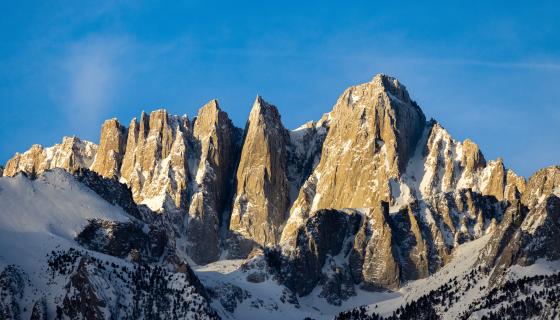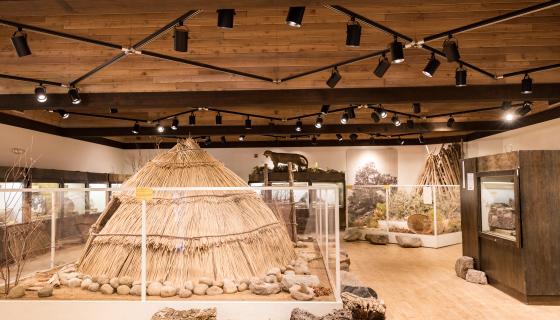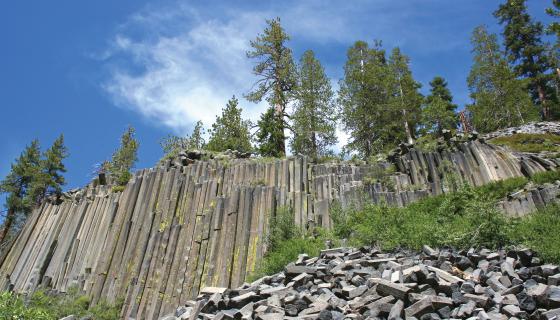The Eastern Sierra of California has long been an iconic destination. From the indigenous Paiute people to early gold miners of Bodie, this area has attracted and enchanted wanderers and wonderers of all types. This larger-than-life landscape of deserts and mountains, alpine forests, and spectacular waterfalls, ranks as one of the most photographed regions in the USA. A land of natural extremes, the Eastern Sierra also holds historical and cultural treasures, with human tales as high and low as its altitudes. Now there is a route that will take you to the furthest extremes of this spectacular part of America.
Welcome to the Eastern Sierra Tour - The Highest, Lowest, Hottest, Oldest, Saltiest, Rockiest, Earliest, Purest, Strangest, Loneliest, Truest Road Trip in America.
For those ready for an adventure that goes beyond the usual road trip limits, the E.S.T. will leave you filled with wonder at the majesty, mystery, and pure magnificence of California’s Eastern Sierra.
The E.S.T. is linear route, spanning over 555 miles and 8600 feet in elevation, from Death Valley at -282 ft to Whitney Portal at 8374 ft above sea level. You can traverse the route from either its north or south extreme, beginning at either Death Valley (130 miles west of Las Vegas) or starting from Yosemite (about 170 miles east of San Francisco).
Either way, it's a journey that reminds you of just how big the Eastern Sierra really is, so you’ll want to make sure your vehicle is prepared. You’ll want to prepare your senses too, for everything from desert heat to icy mountain mists.

Death Valley
Hottest, Driest, and Lowest National Park
Whether you begin or end here, the extreme nature of this massive desert basin must be experienced to be believed. See one of the largest saltpans on Earth with scenery that would look at home on a desert planet from Star Wars. Yet, despite its name, this area hosts a diversity of life, from lush oases to vast fields of wildflowers that appear after one of its rare rainstorms. You could also add another ‘-est’ to its title, as the Largest National Park in the Lower 48.
Open: Year-round
Traveler Tip: Temperatures can exceed 120 degrees Fahrenheit here in the summer. Bring extra water and plan for extreme heat.
Phone: 760-786-3200
Website: Nps.gov/deva


Mt. Whitney
The Highest Peak in the Contiguous US
With spires that rise like dragon’s teeth from the horizon, reaching 14,505 feet, Mt. Whitney looks as unassailable as a medieval fortress. Yet the Whitney Portal Road welcomes you, with views that make it one of the most scenic drives in California. For dedicated mountaineers, there is more than one route to the summit of Mount Whitney, the tallest peak in the contiguous United States. (The route from Whitney Portal is a little under 22 miles round trip, with an elevation gain of 6,134 feet). More casual road-trippers may just want to stop for pancakes at the Whitney Portal Store and Café – no doubt, some of the fluffiest. (Open in the summer)
Open: June-October depending on snow and weather conditions.
Traveler Tip: Whitney Portal Road closes in winter due to snow. You can see Mt. Whitney year-round from the Eastern Sierra Interagency Visitor Center located at the junction of Hwy US 395 and State Route 136 just south of Lone Pine. A permit is required to hike Mt. Whitney.
Phone: 760-876-6200
Website: Inyo National Forest - Mt. Whitney Trail


Alabama Hills
The Roundest, Rockiest Backdrop
If you’ve watched any old western movies, you may have already seen some of the Alabama Hills. This National Scenic Area is home to rounded rock formations, tawny Sierra hills, and hundreds of natural stone arches. The Alabama Hills is a natural playground for hikers, climbers, landscape photographers, plein air painters and nature lovers.
Open: Year-round
Traveler Tip: Stop by the Museum of Western Film History located in the town of Lone Pine to see artifacts from the many of the movies filmed here over the years. 701 S Main St, Lone Pine, CA 93545 Lpmuseum.org
Phone: 760-872-5000
Website: Blm.gov/visit/alabama-hills


Manzanar National Historic Site
The Truest View
If this road trip feels remote to you today, imagine how it must have felt for Japanese American citizens and resident Japanese aliens who were incarcerated here during World War II. The Manzanar War Relocation Center was one of ten military-style camps where more than 10,000 people were detained, some for more than three years. Located between the towns of Lone Pine and Independence, Manzanar is one of the best preserved of these camps to learn their stories.
Open: Year-round
Traveler Tip: You can explore the site on foot or reserve a free ranger-led program for your group’s visit (subject to availability).
Phone: 760-878-2194 (x3310)
Website: Nps.gov/manz


Ancient Bristlecone Pine Forest
The Oldest Living Things
Bristlecone pines grow in the poorest soils and harshest environments, reaching out to the sky from rocky bluffs and outcrops just below the tree line. Some of these gnarled and twisted trees are over 4,700 years old – making them the oldest living things on the planet. Trails from the Visitor Center at Schulman Grove lead you past specimens of varying age and size, with views overlooking the Owens Valley.
Open: Typically late April – early November depending on snow and weather conditions.
Traveler Tip: Beyond Schulman Grove is Patriarch Grove – home of the world's largest Bristlecone Pine, the Patriarch Tree.
Phone: 760-873-2500
Website: Fs.usda.gov/detail/inyo/specialplaces/?cid=stelprdb5129900


Paiute Shoshone Cultural Center
The Earliest Communities
The Owens Valley is home to cultures as old as the Bristlecone pines. A museum and cultural center that serves the community and safeguards its history, The Owens Valley Paiute Shoshone Cultural Center offers insights into the Nuumu (Paiute) and Newe (Shoshone) Nations that originally inhabited the area. These beautiful grounds offer a quiet break from the road, where traditions of the past meet a shared vision for the future of this land and its people.
Open: Year-round
Traveler Tip: Check their website for seasonal events happening monthly in collaboration with local tribes.
Phone: 760-873-8844
Website: Bishoppaiutetribe.com/owens-valley-paiute-shoshone-cultural-center


Devils Postpile National Monument
The Strangest Structures
Tens of thousands of years ago, a thick flow of lava slowed and cooled, contracting into 6-sided columns. Devils Postpile is one of the best examples of these natural basalt columns in the world, some reaching as high as 60 feet. Besides these eerie natural stone towers, the Devils Postpile National Monument offers varied opportunities for recreation, from hiking to horseback riding and sightseeing to wildlife viewing, over its 800-acre site.
Open: May-October depending on snow and weather conditions.
Traveler Tip: A mandatory shuttle bus into Reds Meadow/Devils Postpile leaves the Mammoth Mountain Main Lodge continuously throughout the day. Stop by the Mammoth Lakes Welcome Center for more information.
Phone: 760-934-2289
Website: nps.gov/depo


Mono Lake
The Saltiest Swim
The largest natural lake in California, Mono Lake is an amazing 2.5 times saltier than the ocean and is one of the western hemisphere’s oldest lakes. Mono Lake is one of the most studied – and photographed – bird sanctuaries in North America and is also a beautiful ever-changing oasis of light and color. Photographers love its jagged snow-capped mountain reflections and the eerie spires with the best displays located at the South Tufa Reserve.
Open: Year-round
Traveler Tip: Drop by one of the two visitor information centers in Lee Vining and find out how Mono Lake’s mystical-looking limestone tufa towers are formed and how the lake was saved.
Phone: 760-647-6331
Website: Parks.ca.gov/?page_id=514


Bodie State Historic Park
The Loneliest Town
Turn off a long, quiet stretch of historic Highway 395, get out of your car and get ready to step right into the past. In 1880, the town of Bodie was home to some 10,000 miners, store owners, gunfighters, robbers and people from every part of the world. Now it’s a ghost town of weathered buildings, rust and faded dreams. The California State Park System that manages this property has chosen to leave the buildings in their natural state of deterioration rather than restore them. Yet, Bodie remains impressively well-preserved. You can book ghost walks and tours, or just spend hours wandering its streets, peering in windows and listening for the past.
Open: Year-round however vehicle access on Hwy 270 into the park is open April-November depending on weather and road conditions.
Traveler Tip: The Bodie Foundation along with the park offers daily tours and special events like Friends of Bodie Day and Ghost Walks. Visit the Museum for current information and to register.
Phone: 760-616-5040
Website: Parks.ca.gov/?page_id=509


Yosemite National Park
The Grandest Landscape
For centuries, people have tried to put into words the majesty that is Yosemite. From epic spring waterfalls to towering granite icons like El Capitan and Half Dome, the whole vista seems designed to make humans feel small. Beyond Yosemite Valley itself, the park offers wide-open lakes, peaceful alpine meadows, giant sequoia groves, and much more. Whether you start or finish your Eastern Sierra Tour here, you’ll remember it for a lifetime.
Open: Tioga Pass Hwy 120 (The east entrance) is open May-November depending on snow and weather conditions. Yosemite National Park is open year-round.
Traveler Tip: Parking and traffic can be an issue, especially in Yosemite Valley, during the summer months. Plan to arrive at your destinations before 9am or take YARTS.
Phone: 209-372-0200
Website: Nps.gov/yose


